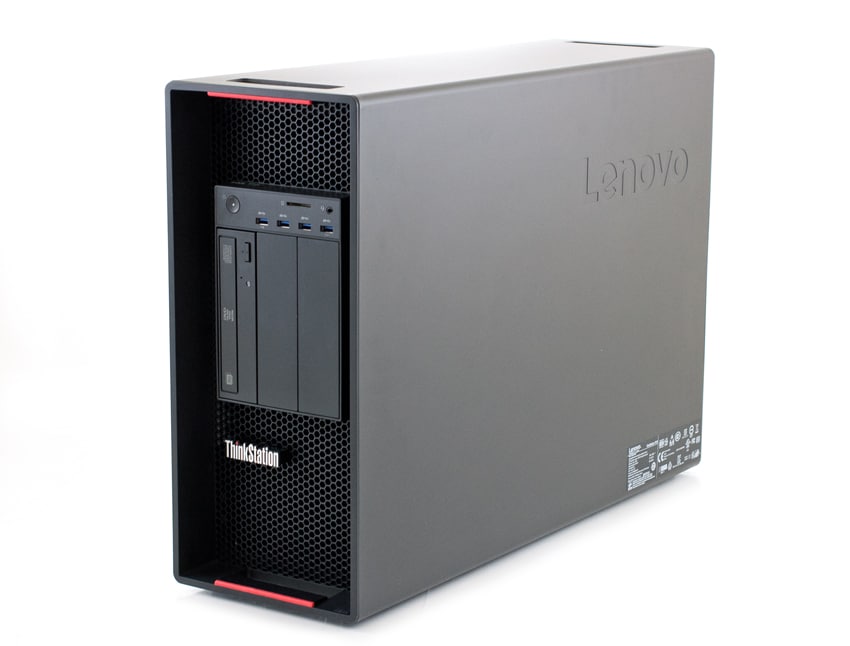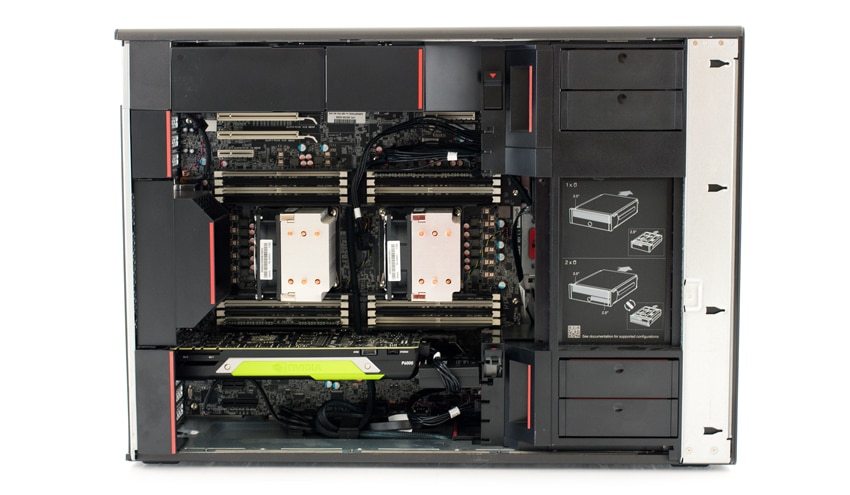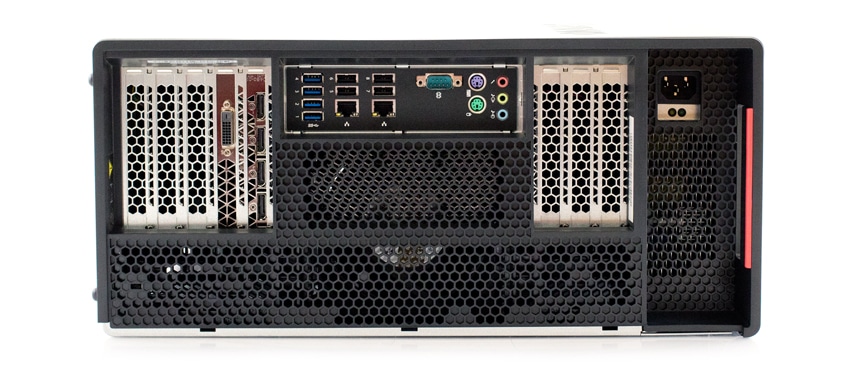
The Lenovo ThinkStation P910 is part of the company’s P-series, a family of rugged workstations that offer higher internal capacity as well as more support for workloads than any of their other previous series. These tank-like workstations can scale to entry level all the way up to the high demands of CAE, R&D, rendering, special effects and Oil & Gas. The P910 is the most powerful model of the bunch, as Lenovo touts it as highest producer of I/O output on the market along with having the largest storage capacity.

This workstation is also highly customizable and can be configured to meet very specific demanding needs. For example, the P910 can be equipped with up to 1TB of 2400Mhz DDR4 memory, Intel Xeon E5 processors ranging from 1.7 to 3.4Ghz, 1TB M.2 PCIe SSD with RAID0, 1, 5, 10 capability, and multiple 8TB 3.5" SATA HDDs for up to 56TB total storage. The Lenovo workstation is also scalable after the purchase due to its four internal drive bays and support for 11 internal hard drives internally. Moreover, the P910 is equipped with 16 DIMM sockets that support up to 1TB of memory via 64GB sticks of RAM.
Our specific unit came with dual Intel Xeon E5 E5-2620 processors, an NVIDIA Quadro P6000 24GB (the second highest end NVIDIA Quadro graphics card), 2x16GB RDIMM DDR4-2400 ECC RAM, and 1TB M.2 PCIe NVMe SSD.
ThinkStation P910 Specifications
- Processor: Intel Xeon E5-2600 v4 Processor (Up to 22 cores, 3.5GHz per CPU)
- Operating System:
- Windows 10 Professional 64-bit
- Linux (Ubuntu pre-load)
- Graphics: Up to 3X NVIDIA Quadro M6000
- Total Memory: Up to 1TB DDR4, 16 DIMM Slots
- Memory: DIMM Capacity
- 8GB/16GB/32GB/64GB
- Total Storage:
- 14 total drives, 4 internal storage bays
- Max M.2=4 (4TB)
- Max 3.5"=6 (48TB)
- Max 2.5"=10 (10TB)
- Storage Type Capacity:
- 3.5" SATA 7200 rpm Up to 8TB
- 3.5" SATA 7200 rpm Hybrid Up to 2TB
- 2.5" SAS HDD Up to 600GB
- 2.5" SATA SSD Up to 1TB
- M.2 SSD Up to 1TB
- RAID: 0, 1, 5, 10
- 14 total drives, 4 internal storage bays
- Power Supply: 1300 W 92% Efficient
- Flex Module:
- Up to 4 Devices
- (1)9.5 mm Slim ODD
- 29-in-1 Media Card Reader
- Ports:
- Front:
- (4) USB 3.0, (1) Lenovo Diagnostics
- Microphone
- Headphone
- (1) 9-in-1 Media Card Reader
- Rear:
- (4) USB 3.0
- (4) USB 2.0
- Serial
- PS/2
- Ethernet
- Audio Line-in
- Audio Line-out
- Microphone-in
- WiFi:
- Intel Wireless – N 72602
- AC 802.11 ac, 2 x 2, 2.4GHz /5GHz + Bluetooth 4.0
- Expansion Slots:
- PCIe x16
- PCIe x4
- PCIe x1
- Flex Connector
- Media Card Reader:
- Integrated 9-in-1
- Optional 29-in-1
- Front:
- Dimensions (W x D x H)
- (mm): 200 x 620 x 446
- (inches): 7.87" x 24.4" x 17.5"
- Chipset C612
Design and Build
When placing the P910 in front of you, the word “tank” or “behemoth” will likely cross your mind, because it is certainly built like one. Though its physical footprint certainly limits where you can place the workstation, it allows the P910 to pack a ton of power that is highly customizable via modular component design. This makes for seamless, tool-less upgrades for added flexibility and scalability.
The P910 features Lenovo’s new “blind connect drive trays,” which aims to make cable management and ease of use more tidy and seamless, respectively. With this new drive tray technology via the ThinkStation backplane design, users no longer need to use cables (i.e. cables for plugging in and unplugging drives) to install drives. The P910 uses a 1300W power supply with Built In Self Test (BIST)–an integrated process that allows a product to test itself.
On the rear panel of the P910, you will see the following ports: four USB 3.0, four USB 2.0, serial, PS/2, Ethernet, audio line-in and line-out, and microphone-in. The entire rear panel also acts as ventilation.
To keep the P910 from overheating, the P910 uses a tri-channel cooling system and proprietary air baffle. Lenovo indicates that it cools vital components more effectively and thus increasing their lifespan.
In our review unit, we equipped the ThinkStation P910 with the Quadro P6000, one of the most powerful professional graphics cards offered by NVIDIA. This powerhouse GPU uses the Pascal architecture GPU implementation, a DisplayPort 1.4 display connector, and features a whopping 24GB in GDDR5X memory. NVIDIA indicates that the P6000 has the ability to seamlessly create large, complex designs, interactively render photorealistic imagery, and create detailed, lifelike VR experiences. This is easily the most powerful card we’ve seen in a workstation.
QUADRO P6000 Specifications
- CUDA Parallel-Processing Cores: 3840
- GPU Memory: 24 GB GDDR5X
- FP32 Performance: 12 TFLOPS
- Max Power Consumption: 250 W
- Graphics Bus: PCI Express 3.0 x 16
- Display Connectors: DP 1.4 (4)
- DVI-D (1)
- Optional Stereo (1)
- Form Factor: 4.4” H x 10.5” L Dual Slot
Performance
To test the ThinkStation P910, we put it through a series of benchmarks to demonstrate its performance when taking on resource-intensive workloads. We also want to examine the performance of its equipped powerful NVIDIA Quadro P6000 professional graphics card. Because of the significant CPU differences (i.e. the P910 is equipped a less powerful model compared to other workstations we've tested), we won’t be comparing it to our previously reviewed workstations.
The first benchmark is SPECviewperf 12, which is the world standard for measuring graphics performance based on professional applications. SPECviewperf runs 8 benchmarks it calls viewsets, all of which represent graphics content and behavior from actual applications. These viewsets include: CATIA, Creo, Energy, Maya, Medical, Showcase, Siemens NX, and Solidworks. In the table below, you can see that the P910 boasted some fairly impressive results.
| SPECviewperf 12 | |
|---|---|
| Viewsets | ThinkStation P910 |
| catia-04 | 153.16 |
| creo-01 | 109.37 |
| energy-01 | 22.67 |
| maya-04 | 94.60 |
| medical-01 | 102.07 |
| showcase-01 | 132.74 |
| snx-02 | 398.16 |
| sw-03 | 156.69 |
In addition to SPECviewperf, we also ran SPECwpc. SPECwpc is a benchmark designed specifically for testing all key aspects of workstation performance and has over 30 workloads it uses to test CPU, graphics, I/O, and memory bandwidth. The workloads fall under broader categories such as Media and Entertainment, Financial Services, Product Development, Energy, Life Sciences, and General Operations. We are going to list the broad-category results for each, as opposed to the individual workloads. The results are an average of all the individual workloads in each category.
Here, the ThinkStation P910 fared very well with another set of impressive results; however, the General Operations category was a bit on the low side.
| SPECwpc v2.0 | |
|---|---|
| Category | ThinkStation P910 |
| M&E | 3.62 |
| ProdDev | 3.65 |
| LifeSci | 4.99 |
| Energy | 5.1 |
| FSI | 6.04 |
| GeneralOps | 1.29 |
Next up is the Environmental Systems Research Institute (ESRI) benchmark. ESRI is a supplier of Geographic Information System (GIS) software. ESRI’s Performance Team designed their PerfTool add-in scripts to automatically launch the ArcGIS Pro. This application uses a “ZoomToBookmarks” function to browse various pre-defined bookmarks and create a log file with all the key data points required to predict the user experience. The script automatically loops the bookmarks three times to account for caching (memory and disk cache). In other words, this benchmark simulates heavy graphical use that one might see through ESRI’s ArcGIS software. It's a safe bet that similar graphics-intensive programs, such as Autodesk’s AutoCAD, will fare closely with the results in this benchmark.
As you can see below, the P910 recorded excellent results during the ESRi benchmark, with results that place it in the upper echelon of workstations. We expect even better results with a higher-class CPU (as is with the case for our SPECwpc and SPECviewperf benchmarks).
| ESRI Benchmark | |
|---|---|
| Drawtime | Average |
| ThinkStation P910 | 00:00:06.674 |
| Average FPS | Average |
| ThinkStation P910 | 385.0334 |
| Minimum FPS | Average |
| ThinkStation P910 | 184.031 |
Conclusion
The ThinkStation P910 is a highly configurable workstation from Lenovo, both in design and performance. It gives users the option of up to 1TB of 2400Mhz DDR4 memory, Intel Xeon E5 processors ranging from 1.7 to 3.4Ghz, 1TB M.2 PCIe SSD with RAID 0, 1, 5, 10 capability, multiple 8TB 3.5" SATA HDDs for up to 56TB total storage, as well as numerous other expansion options. The P910 also has a plethora of professional graphics cards to choose from, ranging from the lowest-class 1GB NVIDIA NVS 310, to three of the wildly powerful 24GB NVIDIA Quadro P6000s.
Though our specific built garnered some impressive overall results, it is capable of even better performance when outfitted with higher clock speed CPUs (our model came supplied with dual Intel Xeon E5 E5-2620 processors at 2.10). Though the P910 can handle most demanding workloads with ease, the P910 does have a large footprint to work around, which may limit more compact deployment settings.
Pros
- Highly customizable
- Supports up 56TB of internal capacity
- Very well built
Cons
- Large physical footprint may limit where it can be deployed
The Bottom Line
The Lenovo ThinkStation P910 can be customized to hit a broad range of high-end workstation use cases in a well-constructed, flexible build.
Lenovo ThinkStation P910 on Amazon
Sign up for the StorageReview newsletter


